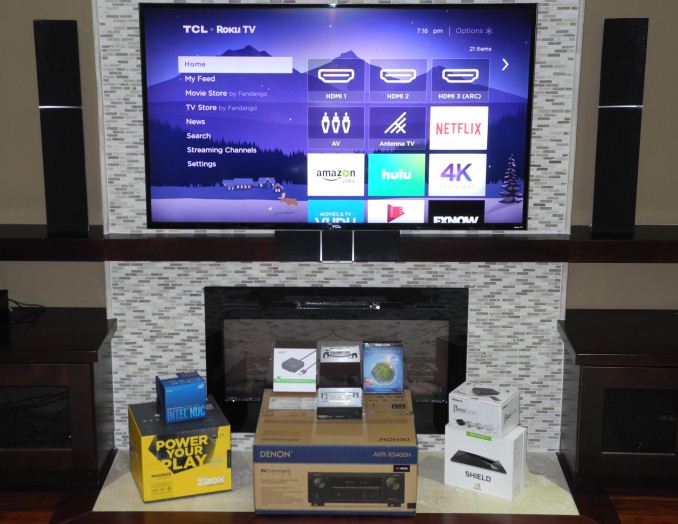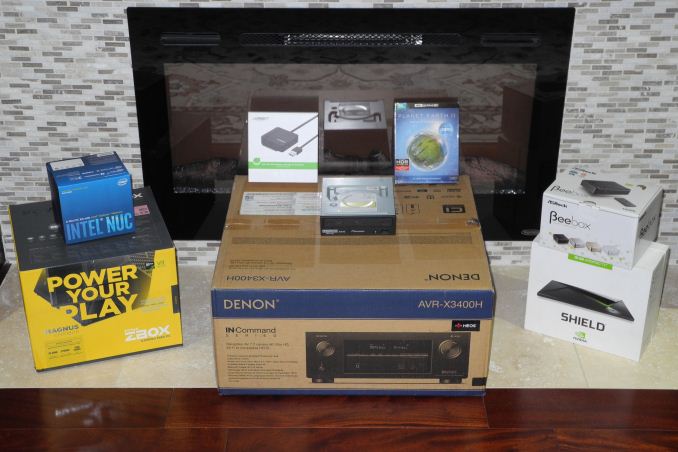A Budget Home Theater & PC Setup: 4K, HDR, UHD Blu-ray, and More
by Ganesh T S on December 26, 2017 8:30 AM EST
The days of bulky HTPCs with built-in optical drives, massive internal storage arrays, and integrated TV tuners are long gone. The advent of over the top (OTT) online streaming services has moved a lot of functionality to the cloud. As NAS units become more powerful, it has made sense to move local media files to a central repository. All these have enabled the TV-connected PC to become more compact. Unless the consumer has specific requirements (like, say, high quality gaming), even ultra-compact form factor (UCFF) machines such as the Intel NUCs can fit the bill.
Home Theater Components: Keeping up with the Times
The primary functionality of HTPCs has evolved to become one of a powerful and versatile media player. However, recent advances such as 4K and high dynamic range (HDR) videos, as well as stricter DRM requirements such as HDCP 2.2 for premium content have made the perfect HTPC platform difficult to achieve. Before delving deeper into these new advances, it is helpful to have some insight into how the landscape has changed over the last decade or so. The advancements in that timeframe have meant that next attractive home theater feature was always around the corner. In the initial days of 720p televisions and other home theater equipment, it was Full HD (1080p). As 1080p became widespread, it was HD audio bitstreaming. After that, 3D support was sought after. A brief lull ensued before the market started slowly getting ready for 4K.
Over the last year or so, we have seen the appearance of displays and audio/video receivers (AVRs) supporting HDMI 2.0 / HDCP 2.2 along with HDR / Dolby Vision. Despite the announcement of HDMI 2.1, I believe that we have reached a point where it is possible to purchase a relatively inexpensive home theater and HTPC configuration without worrying about it getting obsolete within the the next 3 to 5 years.
On the media side, OTT streaming services have become popular to the extent that Netflix and YouTube moved to offer 4K videos to consumers ahead of Blu-rays. Fortunately, many modern PCs are capable of 4K Netflix playback, though HDR is available only on a subset of those configurations. UHD Blu-ray playback support is available through CyberLink PowerDVD 17. However, the hardware requirements are a lot more specific compared to premium OTT services. UHD Blu-ray playback with HDR requires that the home theater components fulfill additional requirements.
Building a Home Theater on a Budget
I started work on this home theater piece back in June 2017. The aim was to present a setup (TV, AVR, and HTPC) with all the bells and whistles, yet light on the wallet. While the TV (TCL 55P607) and the AVR (Denon AVR X3400H) were easy to narrow down based on the feature requirements and budget, the PC side proved to be more challenging. Our core requirements (compact form factor, 4K Netflix support, and HDR capability) narrowed down the choices to a NVIDIA Pascal GPU-equipped PC or a Kaby Lake PC with HDCP 2.2 capabilities. UHD Blu-ray support further narrowed this down to certain Kaby Lake PCs with a HDMI 2.0 / HDCP 2.2 display output.
In the course of our evaluation, we found that consumer electronic (CE) equipment almost always received features ahead of HTPC platforms. Keeping this in mind, we ended up evaluating a number of options for the fulfillment of HTPC duties
- Roku Smart TV platform in the TCL 55P607
- NVIDIA SHIELD Android TV (SATV)
- Zotac ZBOX MAGNUS EN1080K
- ASRock Beebox-S 7200U
- Intel NUC7i7BNHX
Prior to looking at the performance of these options, it will be of interest to readers to delve deeper into our choice for the other home theater components. Earlier this year, I happened to embark on a house remodel, and I took that opportunity to revamp the HTPC test components used in our system reviews. Our choice of components is geared towards a typical family room (15' x 15') home theater.











191 Comments
View All Comments
Kevin G - Wednesday, December 27, 2017 - link
In the market, it seems that 4K using HDMI 2.0 with HDCP 2.2 and HDR has finally settled things down after several years of turbulence. By my count we're at the five generation of consumer 4K/UHD. First we had the wave of 4K support only via HDMI 1.4/HDCP 1.4, then a half step with some HDMI 1.4/HDCP 2.0 displays which didn't see wide spread release as a new generation with HDMI 2.0/HDCP 2.0 was around the corner which could finally do 4k60. Then HDCP 2.2 came out making all the previous HDCP 2.0 displays incredibly short lived. Now we're seeing the advent of HDR being a standardized feature to go alongside 4k. All of this is over the course of 5 years. Finally have things settle down for 4K that getting content on the display as designed is not a headache as it has been in years past. Oh and 4K content is finally arriving with streaming services and 4K disc media.The problem with HDMI 2.1 is that there will likely be three generations of hardware that support. First wave, which will likely be shown off at CES 2018, will focus around higher frame rate transfer or higher resolution. As these devices start shipping in late 2018, there will likely be a new HDCP version to protect 8K content announced to make all the new displays only worthwhile as monitors for the first save of HDMI 2.1 video cards. Hooray for copy protection screwing over the consumer! Then I see another generation of displays accepting variable refresh rate as soon as Sony or MS update their console to support variable refresh rate. Ultimately a good thing gaming but it'll spur another round of obsolete hardware. Best time to adopt would be wait until 8K media has settled own on a distribution medium as once content becomes readily available, there is less incentive to change underlaying spec. That'll still be years away.
fallaha56 - Tuesday, December 26, 2017 - link
Also...Gemini Lake cannot do HDR because of ‘power contraints’ but an iPhone or Samsung can?Really? Or is this just intel at it again
lowphas - Wednesday, December 27, 2017 - link
A <75 usd android TV box can do 4k60fps hdr decode on paper. Usually they have a 5v2a power supply. But I dunno, never had one before.Tv sets are just a display panel and a small (maybe mobile?) soc in my eyes. There is virtually no power or thermal limitation inside a tv. (I have an mu7000 series tv)
So back to the intel cpu... I am just missing some point or it is not that demanding feature so in my opinion it can be maybe a price(ing)* constrain.
Mikzip - Tuesday, December 26, 2017 - link
Is it possible to get HDR out by means of USB C to HDMI adaptor, my HDMI port is only 1.4Kevin G - Wednesday, December 27, 2017 - link
Depends on the system but most USB-C ports that can provide video do so natively by DisplayPort and then convert that over to HDMI. So HDR output is possible because DP supports it but the DP to HDMI conversion chip plays a roll here too.So the short answer is yes but it may not be possible with all adapters.
Mikzip - Wednesday, December 27, 2017 - link
Do you know of any such adapter, the only one i have been able to lokate with HDR are only for the MacBook, and my USB C port don't have ThunderboltKevin G - Wednesday, December 27, 2017 - link
Not off hand that'd be guaranteed to work. Even if an adapter doesn't immediately work, you could try editing the system's EDID table to expose 10 bit color etc. and see what gets passed through. I strongly recommend this testing with a display that accepts HDR via both DP and HDMI so you could compare the results with and with the adapter as a factor.Mikzip - Wednesday, December 27, 2017 - link
I was trying to hook it up to my HDR TV LGB6, all HDMI inputs accept HDR. Editing EDID table are a little out of my league I'm afraid ;-)harshw - Tuesday, December 26, 2017 - link
The BIOS ver for the ASRock Beebox 7200-S is shown as 1.73. The version available for download from the website is 1.60. Was the 1.73 ver also a beta?And any idea of what the LSPCon version was? 1.66?
It's sad that the Intel HD graphics cannot do YCbCr 4:2:2 ...
Nestoritwiz - Tuesday, December 26, 2017 - link
Budget??Don't get me wrong I applaud your choices any of that stuff which I would love to own and it's a combination is a whole oh my God I'd be so happy.
But if the goal was to be on a budget or last three to five years without being update outdated then why would you use a DVD player of any kind three to five years come on we all know streaming is future DVDs are like VHS. Nvidia shield on sale for 149, T5 Samsung hard drive or some equivalent hundred bucks or less, ajisen air mouse remote 25 bucks. Get your home theater system 2 to 300. And you're good to go. Thank you for allowing me to express my thoughts I just think you missed the mark a little bit.
Happy holidays
Stephen